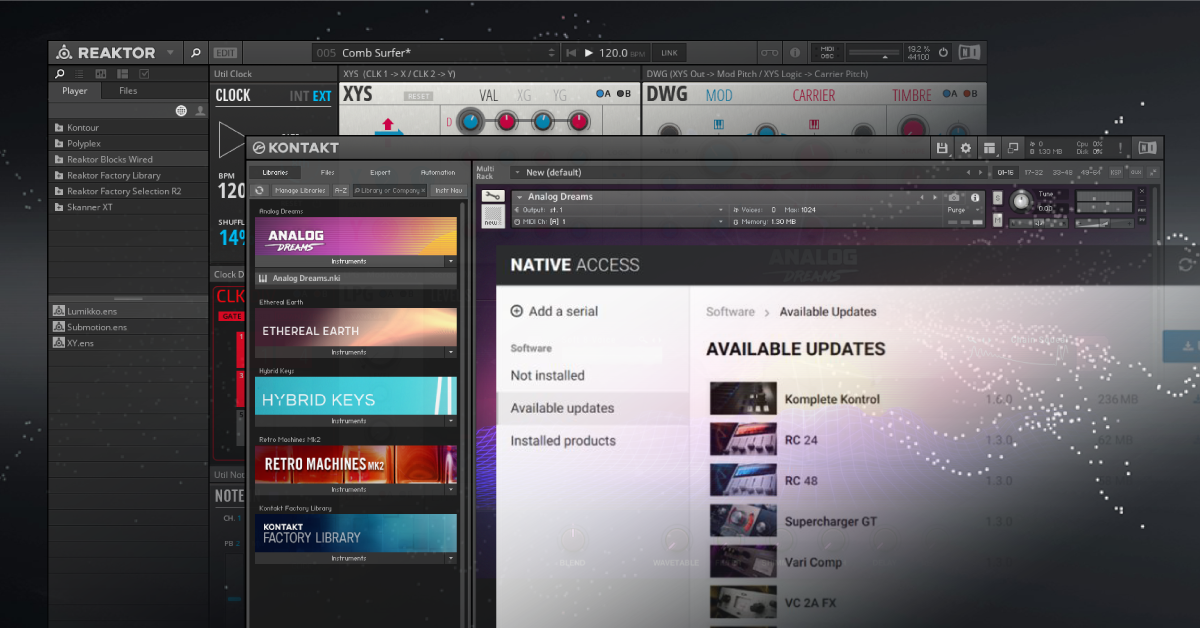
#NATIVE INSTRUMENTS SOFTWARE WTF PRO#
And yes, that does mean you can run VST and AU plug-ins in Pro Tools, VSTs in Logic, and so on.
#NATIVE INSTRUMENTS SOFTWARE WTF PATCH#
What's more, this environment (the Kore plug-in) can be used in any software that supports VST, Audio Units, RTAS, or DXi plug-ins, creating a totally portable patch format. NI realised they could integrate their entire Komplete 3 package into a single environment, and third-party plug-ins could come too. Kore works in exactly the same way, except that instead of building patches from a selection of internal modules, Kore patches (called Kore Sounds) are constructed from other VST or AU plug-ins. This patch is then used stand-alone, or inserted as a plug-in into any recording/sequencing package's mixer. The host software lets you build patches from a suite of effects modules in a virtual rack, then assign the hardware controls to any parameters on the modules. If you haven't seen it, Guitar Rig is a computer-based effects unit that uses a software host controlled by a hardware foot controller. Kore confronts all these challenges in an attempt to combine the advantages of computers with those of hardware synths and effects.Īs well as being close to the problem, Native also had the solution right under their nose with Guitar Rig. In terms of hardware control, you would need to spend endless hours setting up templates to control all these instruments and effects from a traditional MIDI device. If you want a warm pad, you could use Reaktor 5, FM7, Pro 53, Kontakt 2, Kompakt and more. Not only does this mean 13 different user interfaces, but also 13 different places to look for the sound you want. Native Instruments probably felt particularly close to the problems of computer-based composition and performance, as their flagship Komplete 3 package installs no fewer than 13 separate instruments and effects. Workstation sound sources are blended, have appropriate effects, and are available as presets. It's no wonder that keyboard workstations are still popular, because they allow you to compose in one place, with all your sounds together and controlled with the same knobs, laid out in the same way. However, anyone who predominantly uses a computer to make music will have come across the same frustration: you have a number of soft synths, samplers, drum machines, effects and sequencer/recording packages, and it can be a pain trying to integrate these into some kind of workflow. Photo: Mark EwingLike many innovative new products (the iPod is a good example) Kore addresses needs that you may not have been fully aware you had. One of the core ideas behind Kore is that you can choose patches on the basis of what they sound like, regardless of what instrument(s) made them.

A two-in, four-out, 24-bit/96kHz audio interface is also built in. There is, however, a MIDI interface built into the controller allowing MIDI controllers and keyboards to be connected to the computer via the same USB cable. The controller is not a generic MIDI control surface, and is purely meant to control the Kore software and plug-ins hosted in it. It does not provide any DSP hardware: your plug-ins still run using the host computer's processing power. Kore is not a sequencing or recording package it is more like an instrument that draws its sound sources and effects from other plug-ins. Let's start by taking a quick look at what it doesn't do. Kore's announcement was greeted with a cautious reaction in some quarters, and an excited one in others, probably because of the lack of agreement on what it was actually going to do.

This rather dry description may not blow your skirt up, but believe me it's this last feature that could have a profound impact on your desktop music production, and bring your computer much closer to feeling like a musical instrument. In addition to providing a standardised hardware control system, and a means to construct patches from multiple plug-ins, Kore has a powerful patch and preset cataloguing system, creating a centralised database of all the sounds and effects at your disposal. Kore plug-in instances, or the stand-alone host, are controlled with the hardware unit. Plug-ins are hosted within the Kore software 'shell', which appears as a plug-in in your sequencer, or runs as a stand-alone host. Native Instruments' Kore is an integrated software and hardware system that acts as a universal 'front end' to other VST/Audio Units instruments and effects installed on your computer. NI's Kore system promises to unify your library of software instruments and effects, creating the mother of all workstation synths or multi-effects units.


 0 kommentar(er)
0 kommentar(er)
